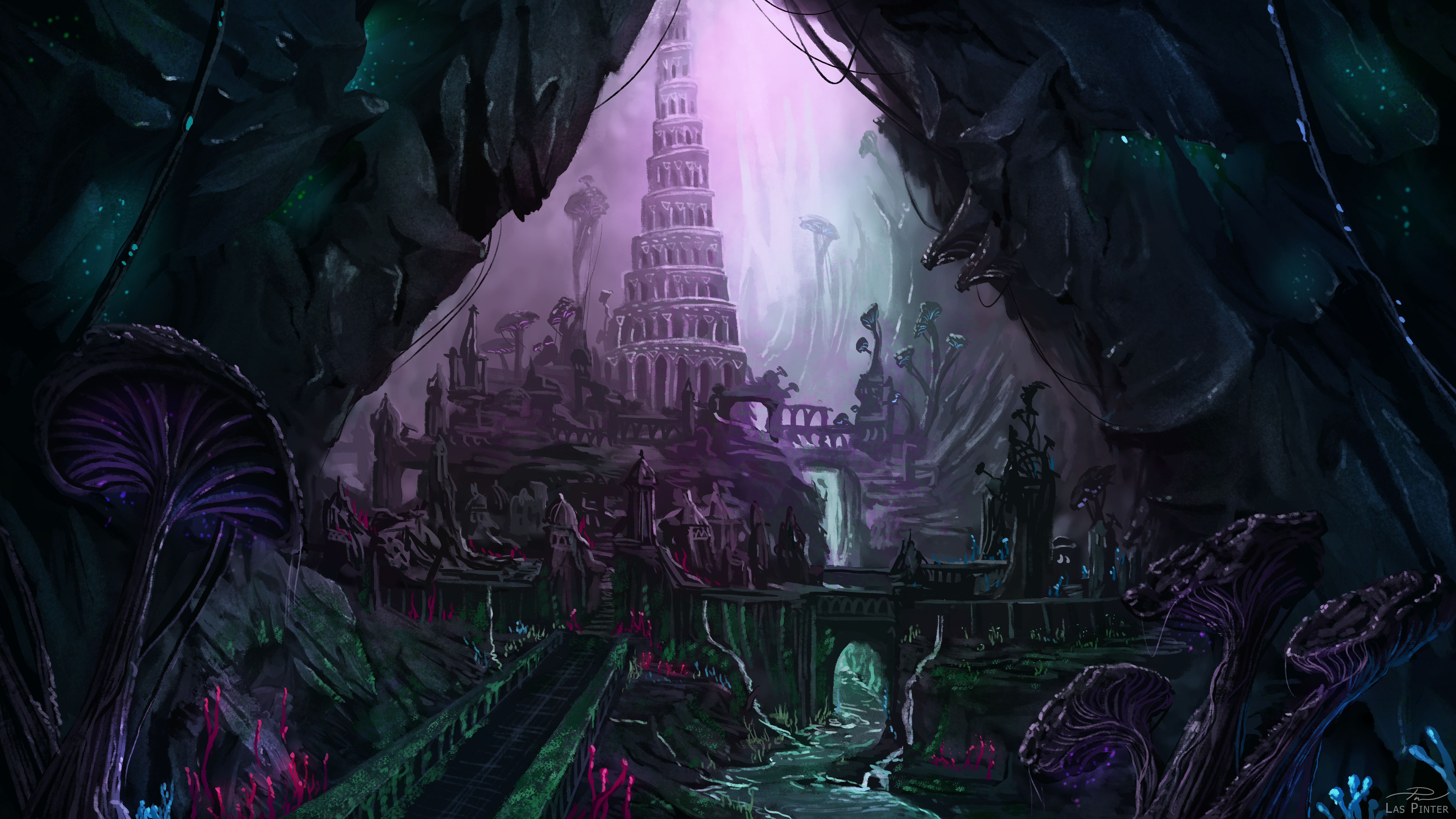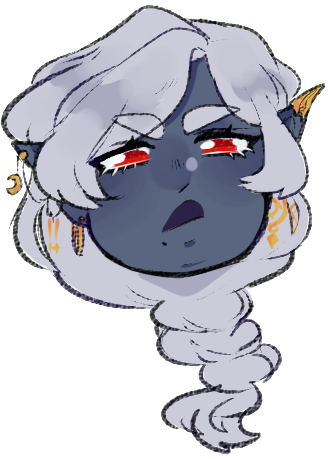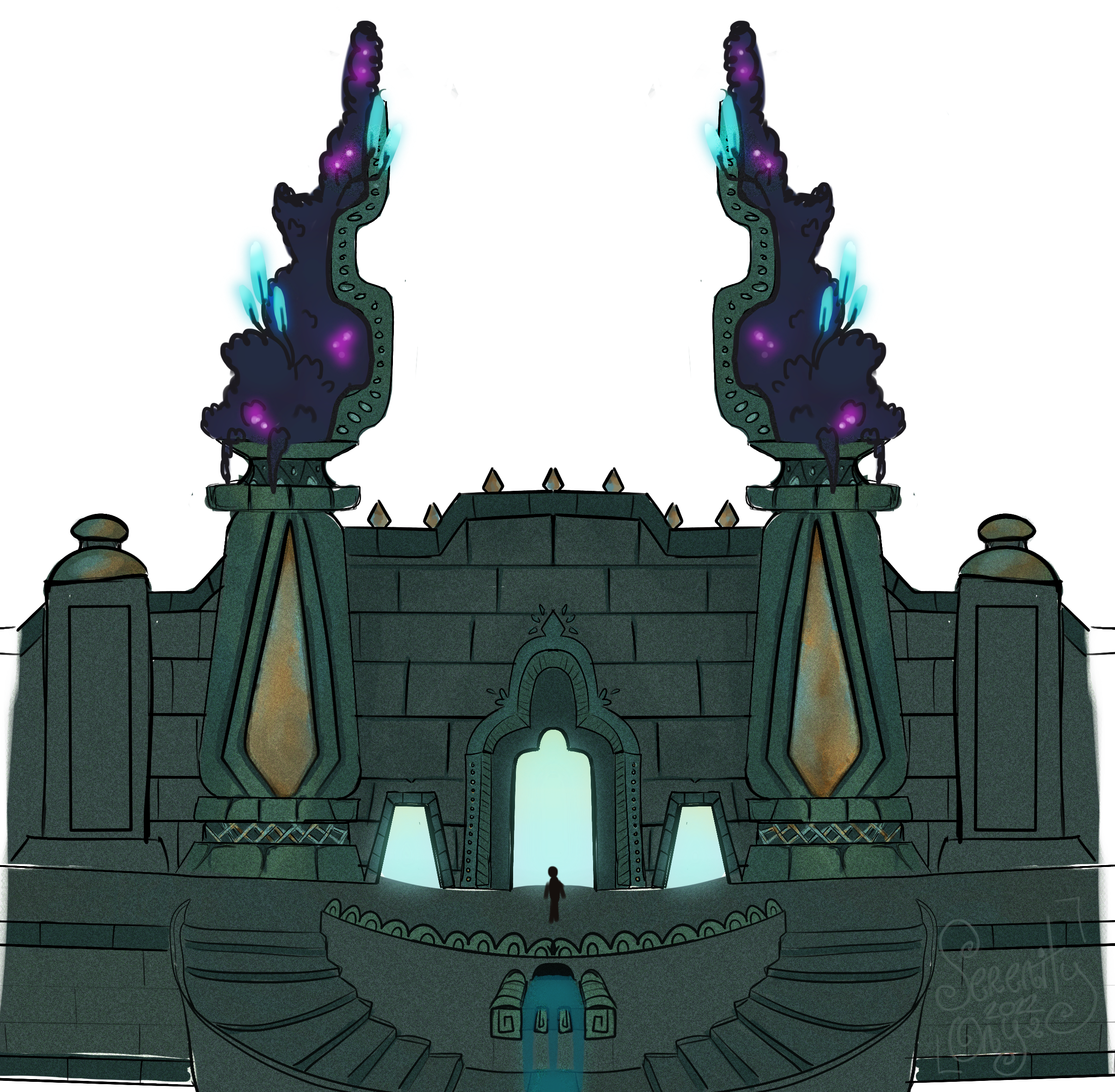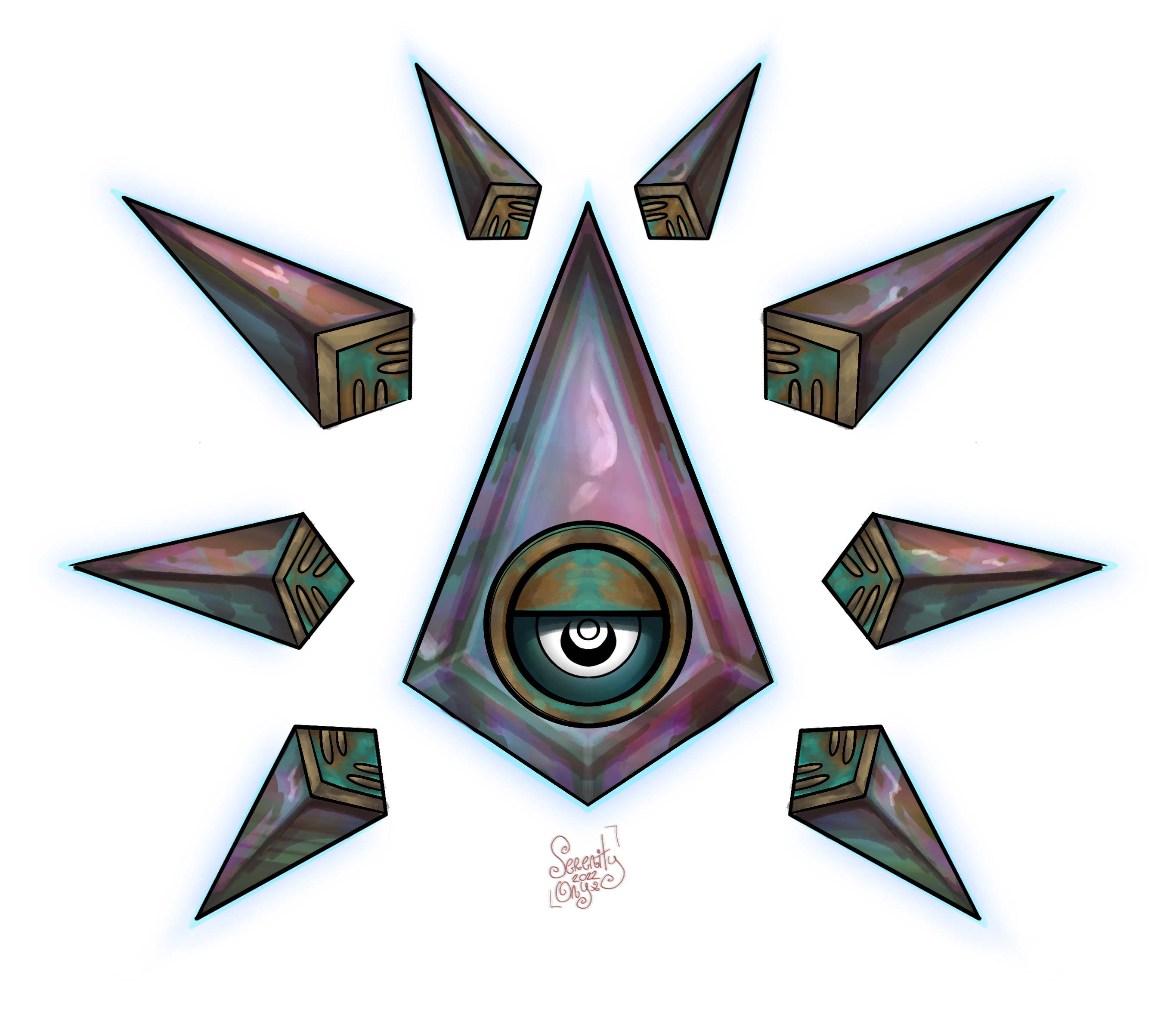The Fallen City of Menor'cress
Menorcress is a story of the Hubris of the Dral'azie people. Who once believed their great city states in The Sunless Realms were too mighty to ever fall. But one day, one did just that. The doom of Menorcress would be a tragedy they would seldom forget.
The city of the prophet Nemiisae., brought to ruin by the folly of a fanatic queen and a wayward druid.
Menor'cress was formerly an enduring sanctum for the Tahli'cuaiisae; a subset of the Dral'azie people that sought refuge within the bosom of the underworld following the events of The Sundering. Led by the enigmatic Nemiisae., the first families of Tahli'cuaiisae founded a settlement deep within the heart the Sea of Spores, naming it Menor'cress and there upon building the foundations for their unique civilisation. Menor'cress was originally recognized as one of The Sunless Realms' largest cities - however due its rapid expansions due to its' religious significance gave it the exaggerated reputation of being a labyrinthine maze; and during its' peak, those pilgrims and tourists who journeyed into the city frequently became disoriented as they attempted to reach the holy site of The Tower of Neyan’catual. Menor'cress would emerge as one of the most influential city-states in the early Imperium, its position as one of the most revered pilgrimage site and the trade and commerce that came with it made the city and its ruling elite very rich and powerful.
The Fall of Menor'cress was an unforeseen calamity. It was a catastrophe surrounded by a series of interwoven events caused by the paranoia of the Mad Queen Ril’Nyiia Ci’huaturu. Fuelled by the ambitions of exterior powers interfering in the growing conflict between the Dral'azie of Menor'cress and the Dvergar of Xhlar'torre. Records surrounding these events are vague and incomplete at best, so much is mere scepticism and educated guess work. The Tahli'cuaiisae were always a fiercely independent people from the Imperial crown of Dragh'zeruel and outside influences, particularly during this period of their history, leaving many in the dark about what led to the city-states' doom.
Menor'cress now stands as a broken ruin of its former glory, laying in the very epicentre of The Sea of Spores. it has been left to decay and rot. Infested by the dreaded mycelium scourge and the abominations it spawns, no living soul has set eyes upon its walls for centuries.
The doom of Menor'cress was a punishment by Aulreth, they defied the Abyss Mother and suffered the consequences for spreading their foul heresy.
Government.
Placeholder
Each section of the city was controlled by a different Noble Family, each with their own specialties and motives, all ruled over by the Ilthicess of Great House Ci’huaturu. Whilst the nobles of the houses and clergy of The Church of Nemiisae jostle for power beneath the Ithicess, the rest of the Citizenry of Menorcress strived to find their place in society, religious dedication and serving the faith or through mercantile ventures. Those who can ill afford such social mobility are either enthralled into indentured servitude or subjugated into the drudgery of slavery. Such is the way of things for the low born in Menor'cress, a common facets found throughout wider Dral'azie society.
The Noble Houses of Menor'cress.
- Great House Ci’huaturu
- House Vlen'shard
- House Meztyl'itta
- House Xi'Huitetl
- House Matlalichtli
- House Tl'Aoxotzin
While many Dral'azie great houses cling onto their positions through cunning, guile and manipulation. House Ci'hauturu's position was akin to that of the Exalt of Draal'grondii. The people of Menor'cress believed they were the decendants of Nemiisae, and therefore ruled by the divine right. A belief Ithicess Ril'Nyiia Ci'hauturu would play upon during the final days of the citystate.
Tiers of the City
The City of Menor'cress is made of two distinct tiers that increase in elevation with the lowest point being where the city entrance is located, home to the marketplace, apartments, shops and slums. Homes and businesses are located on this tier along with the Academy Cavern. Rumour has it that a number of notable businesses once resided on this tier, the blacksmith The Placeholder and the city's most popular tavern, The Placeholder. The higher palatial tier was the home to the illustrious compounds of the noble houses, the grand Temple dedicated Nemiisae. and the great citadel of House Ci’huaturu, from where the fanatical Queen reigned. Dwarfing everything else in the caverns of Menor'cress, at the very heart of the city stands a colossus, the antediluvian tower of Neyan’catual where the divine Nemiisae. underwent apotheosis, transcending to the promised lands above.
Peoples of Menor'cress.
Tahli'cuaiisae.
The Tahli'cuaiisae are perhaps the most significant peoples in Menor'cress. Like many Dral'azie ethnicities, they were formed from the descendants of the Dark Aelfaune cursed and banished for their part in The Sundering. The Tahli'cuaiisae chose to follow the prophet Nemii'sae into the underworld where they rebuilt a new society in the depths.Murilath.
A significant portion of the Menor'cress population were Murilath. Aelfaune that had either turned away from the worship of Aushurie during the sundering or were swept up and cast into The Sunless Realms, and subjected to the same curse as their dark kin. Generally treated as second class citizens to the Tahli'cuaiisae.Goblin.
A commonly phenomenon in most Dral'azie city-states is the appearance of Goblinoids. Menor'cress was no exception, making up the largest population in the city, Goblins acted as the servantile class, doing jobs and tasks that the Tahli'cuaiisae and Murilath thought was either too dangerous or beneath them.The Melusill'ah District.
Walled off from the clamour of Neyan'atual and the surrounding ecclesial buildings and the geological barrier the tiers provided from the squalor of the slums blow. Only the highborn nobility and their servants were permitted to pass through its gates into the Melsusill'ah district, keeping out the undesirable elements. Living in a quiet and secluded atmosphere. It's inhabitants are few, whose noble households have dwelt here for centuries. Standing resolute among the beautiful gardens, piatzas and elaborate architecture of the noble manses, is the Melusill'ah districts most prominent landmark. The ancient palace of house Ci’huaturu; that once stood as the only compound on the plateau during Nemiisaes' time. Since the apotheosis of Nemiisae, house Ci'huaturu's authority has dwindled and the upstart nobility moved in to stake their own claim in this haven away from the rabble below.The Pillar Slums.
At the its peak, the prosperity gained through the pilgrim trade to see the holy sites dedicated to Nemiisae and embark on the pilgrimage of the eternal path was tremendous, lining the pockets of the city's elites. Much to the highborn displeasure however, this new found prosperity led to a population boom. As a consequence the slums dramatically swelled in size, absorbing much of the lower city. While talk began of purging the slums and forcing the lowborn beyond its walls, recent excavations on the western cavern wall of Menor'cress had unearthed a large hollow, a chamber supported by one large pillar. It was swiftly decided to move the bulk of the swelling slums into this new cavern, away from the city proper to restore the aesthetic grandeur of the city. Thus, the pillar slums would be born, a ramshackled maze of housing, bridges and gantries, dug in and around the pillar and cavern walls.The Tower of Neyan’catual
Undeniably Menor'cress' most iconic landmark, the ancient tower predates the rest of Menor'cress by thousands of years. Its original architects are unknown, and its true purpose is an even greater mystery. Scholars have theorised the tower to be some primaeval stronghold or a type of conduit for syphoning the magic from the Effluvium dense cavern Menor'cress is situated in. Whatever it's true purpose, groups of researchers and academics were long defied access to the tower all the way up until the fall of the city. Guarded dogmatically by the Church of Nemiisae., and their belief that the tower contained within it the gateway back onto the world above. Considered to be a holy place where Nemiisae. entered and transcended to the cult's promised lands. Pilgrims come here, surrendering up all their worldly possessions to embark on the same fateful final journey as their divine mother in the hopes they too will transcend. Today, the city is nought but a ruin, infested by the veracious growth of the sea of spores that all but consumed it. It's once proud walls and powers stand definitely amongst the monolithic caps that smother the rest of the forgotten metropolis. It's once bustling streets now a toxic jungle of fungi thick with miasma, spores and other abhorrent forms of plant life. High above it all, like a beacon amidst the endless corruption stands the ancient tower of Neyan’catual, that remains a constant reminder to those foolish enough the brave the Sea of Spores of the folly of Menor'cress.Emblem of Menor'cress and House Ci’huaturu.
Table Of Contents
Simultaneously cursed and blessed by their ancient Goddess, Nemiisae, the Tahli'cuaiisae of Menorcress existed for thousands of years in this land, living deep beneath the surface in their caverns that would one day become their tomb.
RUINED SETTLEMENT
4929 ED.
Founders
Type
Large city
Location under
Included Locations








Comments